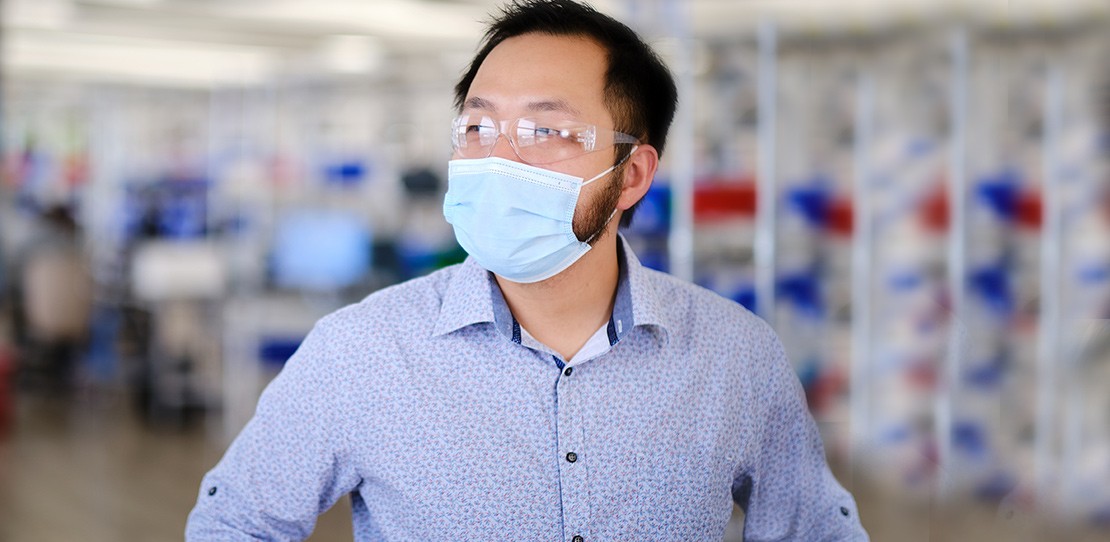
Unscripted: Anthony Scriffignano, D&B’s Chief Data Scientist, Talks Artificial Intelligence
Anthony Scriffignano, an internationally recognized expert on emerging trends in advanced analytics and “Big Data,” busts myths and misconceptions about AI.

Imminent ventilator shortage.
When Dan Purvis of Velentium read these three words on March 15 as the spread of COVID-19 was making headlines in the U.S., he knew his organization — which exists to help change lives for a better world — had to get involved. Little did he know his response, and that of other key players, would spark a chain reaction that would go on to inspire the successful testing and engineering of thousands of medical devices, potentially saving thousands of people during the greatest pandemic of our lifetime.
NI invited Purvis and Chris Brooks of Ventec Life Systems to take us behind the scenes of the teams’ heroic efforts with General Motors to Engineer Ambitiously. This is their story.
Chris Brooks, Chief Strategy Officer,
Ventec Life Systems
Velentium:
After seeing our client Ventec’s call for help in a Forbes article, I reached out on March 17 and within hours booked a flight to Seattle where Ventec is based. We met with GM on Friday, March 20, and it was clear to me in the first 30 minutes that this was the “real deal.” The team GM sent wasn’t messing around, and they set the pace for all of us. There was a five-day period where we had to source over 1,500 different parts as quickly as possible. Every hour mattered. Everything on this project happened faster than I had ever seen before.
Ventec:
We had been tracking the virus since it started in Wuhan, but we didn’t expect the first epicenter in the U.S. to be in our backyard, less than nine miles away. At the beginning of the project, one of GM’s leaders asked our larger team, “if you had a loved one who needed a ventilator, how hard would you work?” That really sunk in. We were bringing new ideas to the table every step of the project. Everyone had a collective mindset and a strong sense of our mission.
Velentium:
Miraculously, GM, with the help of the UAW, transformed a shuttered facility in Kokomo, Indiana, into a mass production ventilator factory in just 28 days. We did seven months of work in three and a half weeks.
Sam Burner, Manufacturing Engineer, Ventec Life Systems
Ventec:
With only about a dozen manufacturers of critical care ventilators globally, we knew that normal manufacturing capacity wouldn’t be able to meet the urgent need with incremental production increases. In one year, global manufacturers produce a total of 60,000–80,000 ventilators; at this point, the state of New York was asking for 40,000 ventilators immediately. It doesn’t take a rocket scientist to see the discrepancy in the math. The enormity of what needed to happen and the fact that so much was unknown was challenging. Typically, most people need ventilators for one to two days, but we were hearing about patients with coronavirus that needed ventilators for weeks. We were trying to understand the magnitude of the problem and solve for the high end of that need, which was 200,000 ventilators. From our first phone call, it was clear the project would only be a success if everyone was transparent and honest about what could be done.
Velentium:
We were working under executive order from the White House and the task was clear: ramp up to manufacturing 10,000 units per month as quickly as possible. Calculations showed we’d need 141 test stands to hit our goal. I had travelled to Ventec to see if we could help build the actual ventilators, but the scale of the GM-backed project made it clear that we were going to utilize our company’s capacity just building the test stands. It required all our partners, especially NI, to think creatively about everything from supply chains to system assembly to logistics and beyond.
NI CompactDAQ hardware is used to acquire data from dozens of sensors, ensuring that each critical care ventilator is ready for deployment.
Ventec:
Prior to that first meeting with GM, if someone had asked me if this could be done, I would have probably said no. To go from manufacturing around 200 ventilators a month to 10,000 or more in just a few months didn’t seem possible. Each company brought its specific expertise to the project. We all knew our role, and everyone was open about their strengths and weaknesses. This created an environment where we could innovate quickly. People ask me if there was a secret to our ability to pull this off; there was no secret — it was transparency and agreement on what needed to be accomplished. The merging of GM’s automotive expertise and culture of safety with medical manufacturing’s drive for precision was a good match. Working with GM allowed us to scale 80 times beyond our normal production capacity, which required flexible and creative thinking from the start.
Velentium:
A few days after I arrived in Washington, my wife and I were talking on the phone, and she said, “This disease is really bad, really scary. Do what you need to do. Stay as long as you have to. Take care of all of us and get that factory up and running!” Her sentiment summarized how we all felt. This project had to work. We’d been preparing for a moment like this since our inception in 2012 by building a culture focused on changing lives for a better world.
Ventec:
It was emotional to see the impact our collective hard work had on the medical professionals who had been working around the clock to fight the coronavirus. One of the most rewarding aspects of this effort was the “one team” attitude shared by GM as well as our incredible partners and suppliers that moved mountains to make this project a success. From day one, we saw the importance of culture and “company fit.” We’re continuing to work hard to fulfill the Federal Government’s order for 30,000 VOCSN critical care ventilators.
Velentium:
When GM CEO Mary Barra was standing in front of us as the first ventilator was being completed, she commented that what we had done together was one of the proudest moments of her 40+ year career at GM. I have to say, I agree with her. I've been doing this for 26 years, and hands down, this was my proudest moment.
Velentium:
Every step in the assembly has a corresponding test step. Component tests make manufacturing efficient, while the final test assures the product is built right and functioning properly. The arrival of the test systems was so important that UPS held a plane for us in Houston to get the first of the test systems out the door.
Ventec:
Working collaboratively with partners such as Velentium and a connector like NI from the very beginning was integral in our efforts to scale at an unprecedented rate with GM.
Early on there was a lot of risk and no guarantee of success. We knew that if you pair bright engineers and an unbelievable task with the resources they need, it would be stunning to see what happens.
–Velentium CEO and Cofounder, Dan Purvis

Velentium:
I was speaking with a Ventec final tester and asked him to tell me about his job testing ventilators. He explained how it was the best job he’d ever had because every time he finished testing a ventilator, he thought about how he just saved another 10 lives (the average ventilator saves 10 people). Without NI as an extension of the team, we wouldn’t have come close to hitting our deadlines. The versatility of the LabVIEW test product made it possible to scale rapidly, which became critical as the scope of the project doubled from one production line to two and the timeline tightened. Without the flexibility of NI’s test product to make these kinds of changes to support creative problem solving, we wouldn’t have been able to write the software in a way that allowed us to select the test based on the changing environment that the project required.
Ventec:
The GM and Ventec teams are committed to quality, something we discussed on our very first phone call. Simply put, quality cannot be compromised for a critical care ventilator; it must have the precision, control and performance that medical professionals need to treat the most serious COVID-19 cases.
Velentium:
Early on there was a lot of risk and no guarantee of success. We knew that if you pair bright engineers and an unbelievable task with the resources they need, it would be stunning to see what happens. I rest easy knowing that if there’s a resurgence in cases, there’s a little town called Kokomo that can now crank out 10,000+ life saving devices a month.
Exactly one month after the first phone call, VOCSN critical care ventilators were delivered to frontline medical professionals battling the pandemic. The federal government order of 30,000 ventilators was fulfilled at the end of August 2020. Ventec continues to make VOCSN critical care ventilators from Kokomo, Indiana, and Bothell, Washington. Source: VentecGM.com. One Team. One Mission, One Month video: https://ventecgm.com/first-month-of-partnership-to-create-vocsn-critical-care-ventilators/